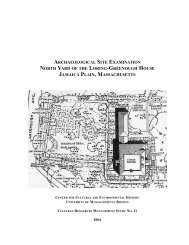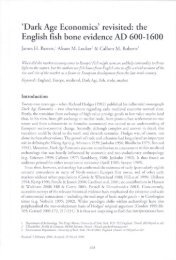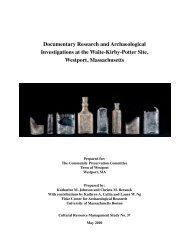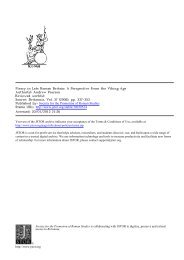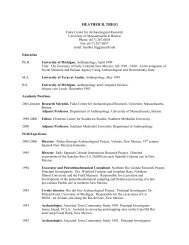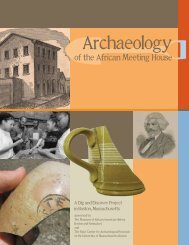Excavations at Glaumbær - Fiske Center
Excavations at Glaumbær - Fiske Center
Excavations at Glaumbær - Fiske Center
Create successful ePaper yourself
Turn your PDF publications into a flip-book with our unique Google optimized e-Paper software.
Figure 6. Areas A and B with extent of midden [51].<br />
Occup<strong>at</strong>ion D<strong>at</strong>es and Site Phasing<br />
So far, all architectural components of the longhouse as well as turf collapse and<br />
overlaying midden deposits identified in test excav<strong>at</strong>ions are str<strong>at</strong>igraphically under the<br />
Hekla 1104 tephra. The inclusion of tephra from the eruption of the Veidivotn-<br />
Dyngjuháls volcanic system d<strong>at</strong>ed to approxim<strong>at</strong>ely 1000 AD (Ólafsson 1985;<br />
Sigurgeirsson 2001; Sveinbjarnardóttir 1992) in parts of the turf used as construction<br />
m<strong>at</strong>erial for the longhouse sets a last phase of the occupied longhouse firmly in the 11 th<br />
century. The construction of the skáli itself may d<strong>at</strong>e to before the V~1000 tephra. There<br />
were also cultural layers under the V~1000 tephra found outside the longhouse in one of<br />
the 2002 test trenches. It is important to note th<strong>at</strong> the V~1000 tephra layer is not a<br />
historically d<strong>at</strong>ed tephra and th<strong>at</strong> the d<strong>at</strong>e is only approxim<strong>at</strong>e.<br />
Acknowledging the limited investig<strong>at</strong>ion of the early phases of the site, the occup<strong>at</strong>ion<br />
can be tent<strong>at</strong>ive d<strong>at</strong>ed to begun in the l<strong>at</strong>e 10 th century and continued into the 11 th century.<br />
Samples taken for radiocarbon d<strong>at</strong>ing during the 2002 test excav<strong>at</strong>ions support an 11 th<br />
d<strong>at</strong>e for the last phase of occup<strong>at</strong>ion in the skáli (Steinberg 2004). Activity <strong>at</strong> the site<br />
appears to have continued after the longhouse was abandoned as a domestic structure.<br />
Infill in the collapsed structure contains both turf and layers of ashy midden. Middens<br />
also overlay and are cut into the collapsed structure. This activity appears to have<br />
continued until the close of the 11 th century as the 1104 tephra fell directly on top of<br />
exposed middens in many places.<br />
The continued use of the site as a dump and possibly for iron working or production as<br />
well as other activities <strong>at</strong>test th<strong>at</strong> the abandonment of the longhouse as a domestic<br />
structure did not correspond to an abandonment of the farmstead. In all likelihood the<br />
occup<strong>at</strong>ions moved the short distance west to the site of the medieval turf house and<br />
contemporary museum. Test excav<strong>at</strong>ions in the domestic midden associ<strong>at</strong>ed with the<br />
10



